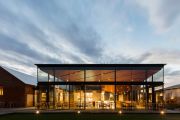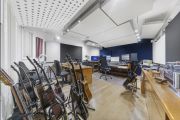
How the west is waking up to night-time
In 1925, about 20 returned servicemen got together at Cabravale town hall, and decided to form a club that would allow diggers to connect as mates, look out for each other, and help local people in need. Their first clubhouse was an old army hut from Dubbo, bought at a cost of 130 pounds.
That club now has almost 100,000 members. And when its impressive new flagship destination – the Cabravale Club Resort – opens next week, it will have a 140-room hotel, six dining venues, an events and convention venue, bars, live music and kids’ areas, and a gaming floor. The owners are calling it Australia’s “first integrated club resort”.

Times have changed. And so has western Sydney.
“Western Sydney is one of the fastest growing regions in the country,” says the resort’s chief commercial officer, Vicki Le. “There’s lots of energy, lots of creativity, lots of ambition. This is really to cater to that growth.”
With business lending growing at above the state average, and investment in infrastructure such as the Western Sydney International Airport and Aerotropolis driving jobs and business growth, there’s plenty of positivity in the west, and the resort believes it can tap into that.
The new facilities take the diggers club distinctly upmarket. The hotel is the plush Novotel Sydney Cabramatta, complete with resort-style pool, gym and wellness facilities. And restaurants include Magma by Dany Karam, “celebrating the theatre of cooking with fire”, and Primitivo, “an elegant steakhouse specialising in dry-aged Wagyu”.
The proximity of the new airport should make it easy to fill hotel beds, Le believes, with guests ranging from airport staff and business travellers to families jetting in from all over the world to visit their relatives in multicultural western Sydney.
The resort also provides nightlife options that the region is crying out for, Le says.
“I think there is major demand for people to see more entertainment in the west,” she says. “We have seen the trend of people not going to the city anymore. Over the weekend, and throughout the week, they are looking for a local experience to enjoy. This is somewhere they can belong, and have a dressy night out without going all the way to the city and paying a premium.”
Night-time coming to life
The west’s night-time economy appears to be going in the right direction. In-person night-time transactions in Sydney’s south-west and Parramatta regions increased 21 and 17 per cent respectively between 2019 and 2025, according to data from Visa. This compares favourably with the CBD (up 15 per cent), the eastern suburbs (up 12 per cent), North Sydney (down 4 per cent) and Hornsby (down 8 per cent). This is even though south-west Sydney and Parramatta both have a lower “vibe score” than the CBD, says Visa – with fewer entertainment options.
But hospitality lending in western Sydney was up 25 per cent in the year to May 2025, and that lack of vibrancy is something that’s starting to change, says David Rowe, Emeritus Professor of Cultural Research at Western Sydney University’s Institute for Culture and Society.
“A real problem for western Sydney in the past is that it’s been regarded largely as a dormitory area, with cheaper housing, so people can essentially park themselves there and then have to commute,” Prof Rowe says.
“If you commute long distances, you probably don’t feel much like going out at night. And there might not be much near you to go to if you do want to have fun.
“But that’s changing… there is more going on, there are more people, they are younger… and western Sydney is a major economy in its own right… It’s much more economically and occupationally diverse than you might think.”
Prof Rowe says state government and council efforts to revitalise the night-time economy are having an effect. “So-called vibrancy reforms are providing the capacity to eat on the street, for example, and allowing more things to go on… without destroying the amenity of people who live around night-time economy precincts.”
He adds, western Sydney is also experiencing a diffusion of night-time activity, with a wide range of attractions – not all based on alcohol – opening in different suburbs, rather than funnelling everyone into one spot. That’s good for the economy and for liveability. And new openings, such as the Cabravale resort, can only help.
“One of the things that you learn about the night-time economy is that activity breeds more activity. Smaller businesses also benefit as you create a kind of hub, and encourage habits of locals getting out and about and doing different things,” says Prof Rowe.
The club isn’t finished yet, Le says. Plans for future development include a karaoke bar and more dining and community facilities. “Our number one vision is to make Cabravale Club Resort the premier entertainment destination in western Sydney,” she says.
But veterans and their families can rest assured that some things won’t change. At 11am each day, a bugle will still invite everyone to stand for a moment of reflection.
“Our vision is to make Cabravale Club Resort the premier entertainment and lifestyle destination in Western Sydney,” says Le. “This is just the beginning – there’s more to come as we continue to expand our dining, entertainment and community offerings.”
Cabravale Club Resort invites guests to stay, play and celebrate from November 15. Find out more or make a booking at www.cabravale.com.











